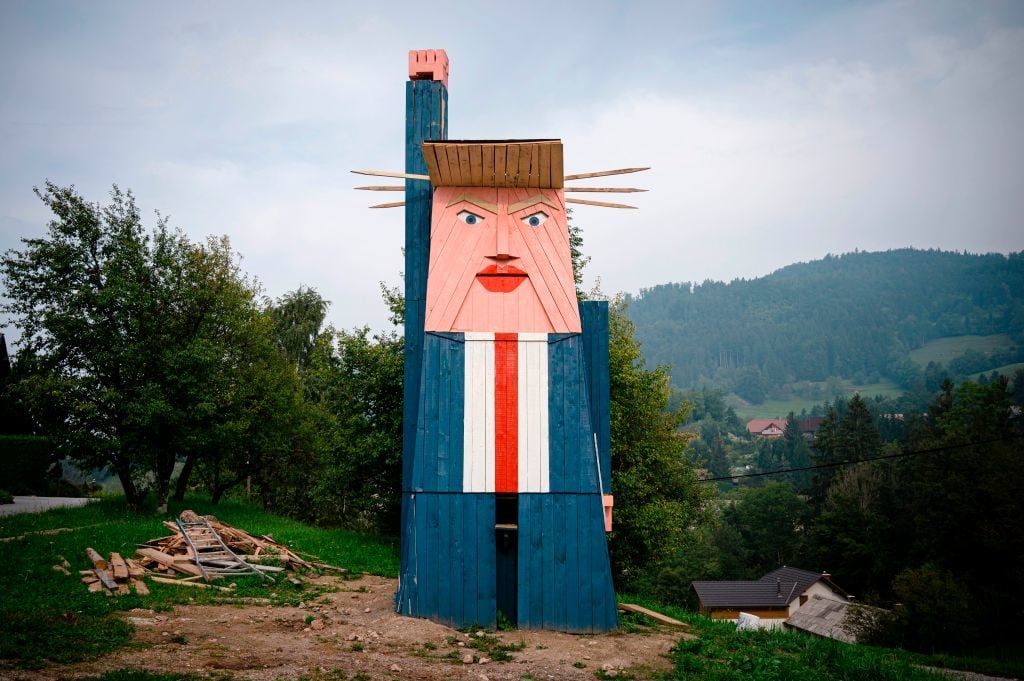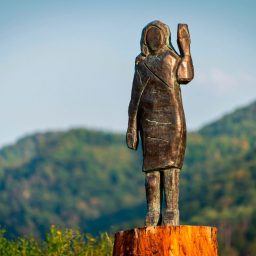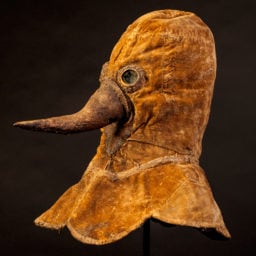Arsonists have torched a giant, folk art-style sculpture that looks like Donald Trump. The 25-foot-tall wooden sculpture, called Statue of Liberty, had recently been moved to a Slovenian village after it had been threatened in its original home. The local mayor, who had provide asylum for the work, has vowed to replace it in stone as police hunt for the culprits, who struck before dawn on Thursday, January 9.
The sculpture depicts a blond-haired man with his right arm raised in the style of Lady Liberty. But instead of a torch, the figure is holding up a clenched fist.
The work, by the Slovenian architect and artist Tomaž Schlegl, caused a stir last August when it was first erected outside the village of Sela. He wanted to turn the sleepy village into a tourist destination, as well as to provoke discussions about populist political leaders who claim to represent the will of the people.
The nutcracker-like kinetic sculpture was capable of two expressions, intended to serve as a commentary on the two faces of populist politicians. The sculpture’s tight-lipped neutral face could give way to an angry gaping mouth revealing pointed teeth.
Schlegl has been adamant since the sculpture was first unveiled that the figure is not Donald Trump, but a statue of liberty, although he says the US president makes for a good personification “because he has shown that he can do and say whatever he wants and he won’t be held accountable.”
Speaking to Artnet News after the incident, Schlegl explains that he was not surprised by the attack. “The statue triggered violent emotional reactions in people, which is in some sense the purpose of provocative art,” he says, adding that he had initially envisioned the project to end with the statue being burned in an artistic performance anyway. “Of course, there is a difference when the destruction of the artwork is a part of the author’s performance, or when it is cultural barbarism. I am strongly against the latter,” Schlegl says.
The artist credits the statue’s resemblance to Trump for raising the public’s hackles so much. “His outrages and actions are feared by the whole world,” Schlegl says. “With his provocative image the statue sets a mirror to today’s politics, which is full of blatant slogans and populism.”
Because of the fiery tensions provoked by populists like Trump, the artist says that many people missed the message of his work. “They only saw Donald Trump in it,” he says. “The arsonist also probably didn’t understand the meaning, as the statue was, paradoxically, created and destroyed for the same reason: for disagreeing with the ‘democratic arbitrariness’ of the populist, who interprets democracy in his selfish way.”

A wooden structure made to resemble US President Donald Trump in the village of Sela pri Kamniku, Slovenia. Photo: Jure Makovec/AFP/Getty Images.
This is not the first time the sculpture has evoked the ire of the public. An industrious group of locals helped the artist-architect create the provocative sculpture—but not everyone was happy with the attraction. Some villagers in Sela were overwhelmed by the international attention the work was garnering, and others called it an eyesore and threatened to destroy it. One angry local even tried to mow it down with a tractor.
In order to save it from vandalism, the work was given asylum in December by the mayor of another village called Moravče. The mayor, Milan Balažic, hoped that it would boost tourism, perhaps drawing inspiration from another popular folk art sculpture of the First Lady Melania, which was installed near her hometown of Sevnica.
Speaking at a press conference after the blaze, Balažic condemned the destruction of the work. “The author of the sculpture has repeatedly pointed out that the Statue of Liberty speaks of freedom and peace,” he said, according to the Slovenian outlet MMC. “Today’s attack by arsonists is a manifestation of Slovenian political culture and intolerance towards artistic projects in our society.”
Two days earlier, there had been another attempted arson attack on the sculpture, and it is thought that the same perpetrators came back to finish the job. “In the Middle Ages, witches burned, Nazis burned books, but today we have come so far that some burn statues,” Balažic said.
The mayor will not be defeated, however. He is reported to be planning a new stone statue to be erected on the hilltop as a reminder for visitors to strive for tolerance.










